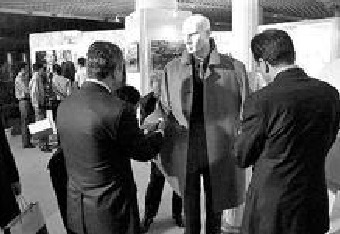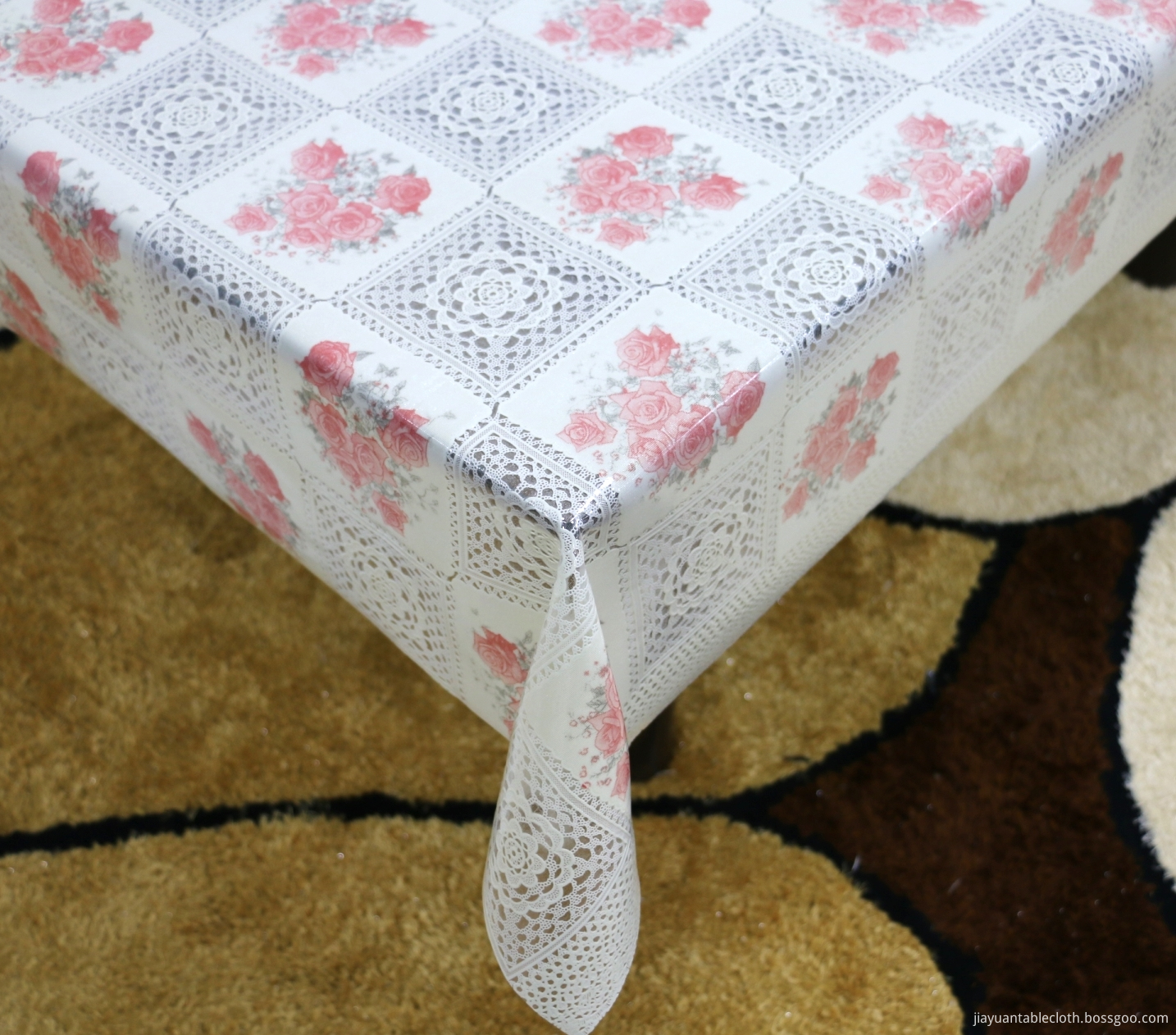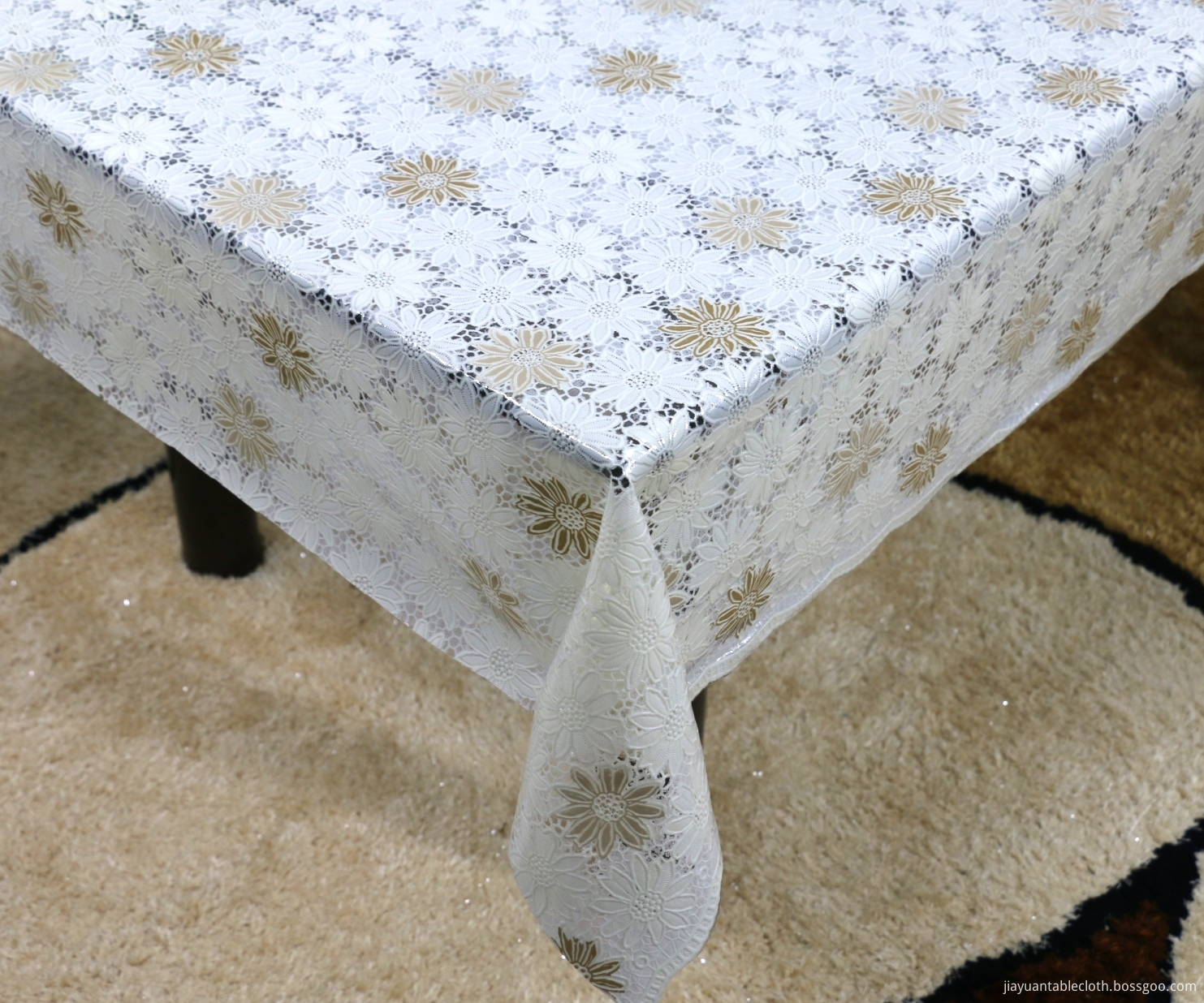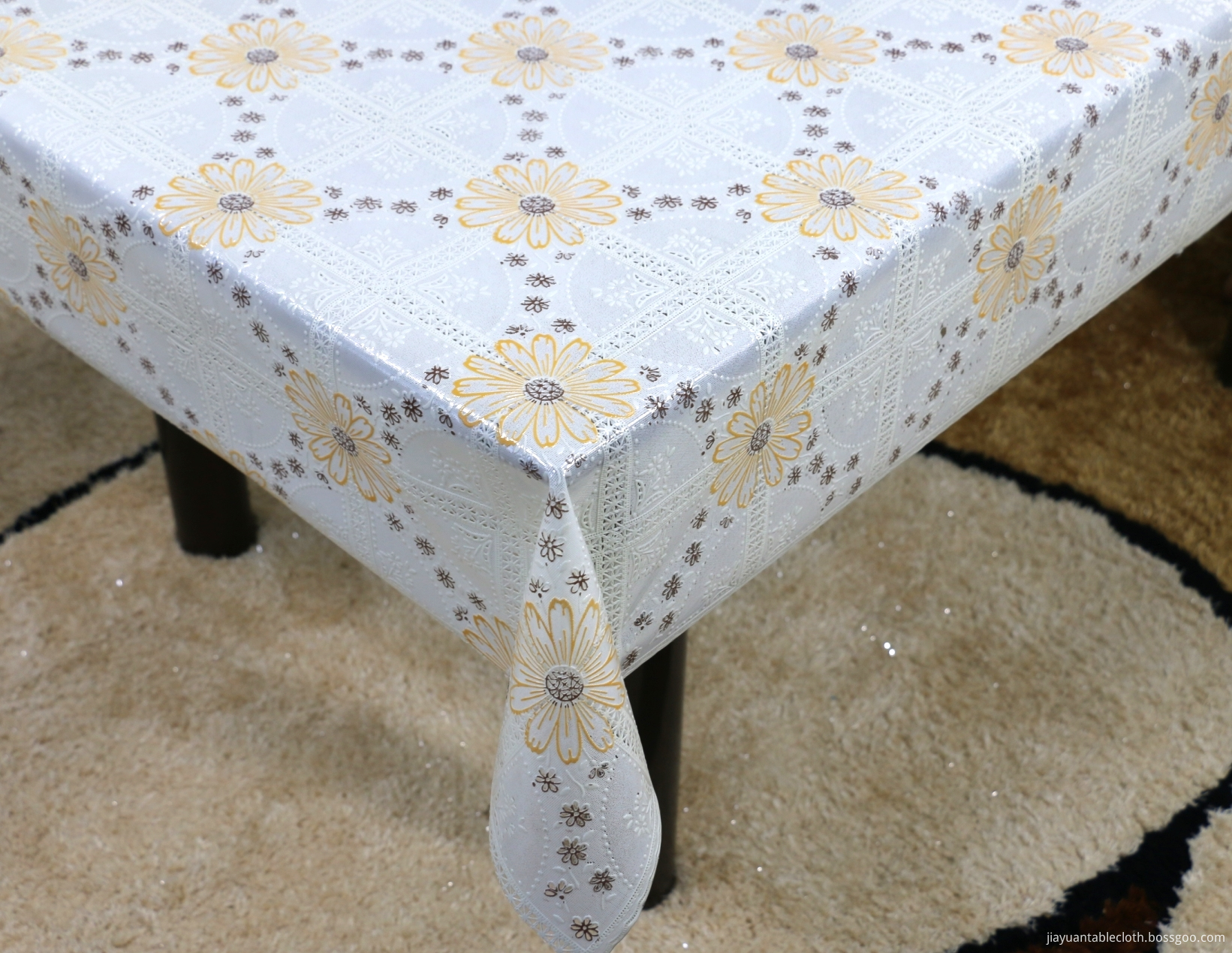Here you can find the related products in printed PVC Lace Tablecloths, we are professional manufacturer of printed pvc lace Tablecloths,Vinyl Lace Tablecloth, PVC Lace by Roll, Gold Lace , Silver Lace. We focused on international export product development, production and sales. We have improved quality control processes of pvc lace to ensure each export qualified product.
If you want to know more about the products in pvc lace, please click the product details to view parameters, models, pictures, prices and other information about pvc lace Tablecloths,vinyl lace tablecloth, pvc lace by roll,Gold lace, Silver lace
Whatever you are a group or individual, we will do our best to provide you with accurate and comprehensive message about pvc lace !
Product Name
Width
Pattern Design
3000 meters per design
Certificate
Features
1).Environmental protection,comfortable use
2) Good quality, comfotable handing, nonfading,fashion.
3) Waterproof, oilproof,wear resistant, non toxic, durable, easy to clean and care
4) We can make different style,size,color and according to clients' request
5).We can open the new mould according to the buyer's original sample
and technical drawings
1.Rolled with paper tube
2.Packed with transparent plastic bags(weight of roll is as per customer
requirements)
Price
Printed Lace Tablecloth, PVC Printed Lace Tablecloth, Vinyl Printed Lace GuangZhou JiaYuan Houseware Co.,Ltd. , https://www.pvc-tablecloth.com China is the world’s largest garment exporter, accounting for one-third of the world’s market share. However, China’s garment export volume has recently been negative for 13 consecutive months. Orders from Spain, Italy and other countries have been severely reduced.
China is the world’s largest garment exporter, accounting for one-third of the world’s market share. However, China’s garment export volume has recently been negative for 13 consecutive months. Orders from Spain, Italy and other countries have been severely reduced.
What is more serious is that while the cost of garment processing in China continues to increase, many countries and regions have already formed alternative production capabilities for “Made in China†in the low-end and general product categories.
Export orders have decreased, and fierce competition from emerging markets and neighboring countries and regions has plagued the Chinese textile and apparel industry. The export landscape is quietly changing.
This year is the most difficult year for textile and apparel exports. The continuous decline in the share of China's textile and apparel exports in the global market is affecting the sensitive nerves of foreign trade companies.
“China's garment industry is facing a severe situation: sluggish external demand, slowing domestic demand, decline in efficiency are already objective facts that cannot be avoided, and there is no fundamental improvement in the short term. This is also illustrated from another perspective, after nearly 30 years of rapid growth. , China's textile and garment industry is entering an important period of adjustment and transformation. "This is what China's clothing and textile industry association president Evergreen said.
The latest data released by the China Garment Association also shows that the number of Chinese garment exports has been negative for 13 consecutive months. From January to September, the increase in the sales revenue of 14328 large-scale enterprises in China dropped from 13% at the beginning of the year to about 10%, which is lower than the average level in the past two years. The profit rate also decreased from 6% at the beginning of the year to 5.09%. At present, loss-making companies account for 16.32% of enterprises above designated size.
Xie Fangming, director of the Industry Department of the China Textile Information Center of the China Textile Industry Federation, pointed out: “The textile and apparel industry has been affected by the economic crisis and exports to Europe have continued to 'lose out of the city'. This trend may continue into 2013.â€
China is the world’s largest garment exporter. China’s textile and apparel products export account for one-third of the world’s market, and its trade is spread all over the world. According to relevant statistics, China’s annual total garment exports exceed 200 billion U.S. dollars. However, the export structure of this huge industry is quietly changing.
Order transfer factory relocation In November, Zhang Xinmin, vice president of the China Textile Import & Export Chamber of Commerce, stated at the Canton Fair that at present, the transfer of textile and apparel orders is significant, especially the European market and the Japanese market orders. “The economic downturn has made consumers more sensitive to prices, and low-end clothing is more popular. There are many orders in Japan and the EU that have shifted to Bangladesh, Vietnam, and Cambodia where labor is cheaper.â€
According to Guan Tianqi, general manager of Zhongshan Silk Group, at the beginning of this year, one of its major customers in the United States changed the silk products originally imported from them into chemical fiber fabrics and transferred large quantities of orders to India.
David Trumbull, vice president of the National Textile Association of the United States, said that in recent years, the rapid growth of textile and garment industries in Mexico, Vietnam, and India is an indisputable fact. In India, the factory owner could not find enough workers to meet the large increase in orders; in Vietnam, the total amount of orders received by garment companies increased by more than 20%. Among them, quite a few orders were transferred from China.
In response, Zhang Xialing, deputy director of the Foreign Trade Department of the Ministry of Commerce, believes that the world trade pattern of textiles and garments is changing. Although the status of China’s world-famous clothing country has been consolidated, the clothing industry in Bangladesh and Vietnam has risen to replace Korea and China. , Become an important clothing supplier.
In fact, the cost of labor in India, Pakistan, and Vietnam is only 38% of that in China. The cost of raw materials is only 70% of that in China, and its export prices for textile and apparel are much lower than those in China. In this context, new orders have turned to these countries.
In addition to the transfer of orders, signs of factory migration have begun to appear. It is understood that the main reason for the transfer of factories is to evade tariffs. According to public information, goods exported from China are subject to an import tariff of 9% in Japan, and tariffs of more than 10% in the United States, but they can be exported to almost zero tariffs in many countries in Southeast Asia.
However, analysts believe that Bangladesh, Vietnam and other countries have limited clothing production capacity due to their limited population. Currently, the two countries' annual textile and apparel exports are at a level of more than US$10 billion, and China’s annual textile and apparel exports worth US$250 billion. The amount does not constitute **.
The "gray" risk behind the growth in exports to Russia After Russia's accession to the WTO, China's textile and apparel exports to Russia have increased substantially. Data show that from January to November 2012, Nanjing exported 380 batches of Russian clothing with a value of 14 million US dollars. Compared with the same period of last year, batches and amounts increased by 43.4% and 17.5% respectively.
According to another data, from January to August before Russia's accession to the WTO, the inspection and quarantine bureau of the People's Republic of China examined a total of 1,013 batches of Russian textile and clothing products, an increase of 3.26% year-on-year. From September 1 to October 21 after Russia's accession to the WTO, 209 batches of Russian textile and clothing products were exported from the Fujian Inspection and Quarantine Bureau area, an increase of 96.23% year-on-year, an increase far exceeding the previous level. This shows that Russia's accession to the WTO has led to the export of textile and garments from Russia to Russia.
“In the Russian clothing market, 'Made in China' can be seen everywhere, but there are few Chinese brands that can make noises.†Xu Liguo, head of the marketing department of Jiangsu Golden Sun Textile Technology Co., Ltd. admitted that this year's exports to Europe and the United States have fallen and Russia has become a gold One of Sun's major export markets. After the accession to the WTO, Russia’s average tariff will gradually decrease from 9.5% to 7.4% in 2013, to 6.9% in 2014, and to 6% in 2015, which will provide opportunities for textile and garment companies to exploit the Russian market.
In fact, Xu Liguo is also very worried: the advantages of Chinese textile and clothing exports to Russia have basically disappeared. In the past, one of the major advantages of China's textile and apparel industry was “cheapâ€. Today, “Made in China†is not cheap at all. This is because before Russia's accession to the WTO, many of China’s goods entered Russia through “grey customs clearance,†and the cost of customs clearance was very low. However, these goods do not have legal status after they enter the country.
According to reports, Bosideng has also experienced the same experience. In 2000, Bosideng set up a permanent point in the Moscow Friendship Mall. He had planned to invest 50 million US dollars in the Russian market as a brand, but he gave up after calm considerations. The reason is that the Russian government has not resolutely cracked down on the "grey level." So far, Bosideng has sold more than 10 million down jackets each year in the country, but it is only doing wholesale business in the Russian market, selling more than 100,000 pieces each year, which is insignificant compared to the total amount.
Xu Liguo believes that Russia’s accession to the WTO means that it must follow international rules in the end. Reducing tariffs and clearing "gray customs" is a must. But this opportunity will obviously not come immediately. According to the Russian official's statement, the WTO gave Russia a maximum of 7 years of buffer period, and it will take several years for Russia to fully implement its commitments.
Brazilian clothing into the emerging market Brazil has now become the main emerging market after China and India. According to public statistics, in 2001, bilateral trade between China and Pakistan was only US$3.7 billion, and in 2011 it had reached US$84.2 billion, with an average annual increase of 36.7%.
In 2012, Brazilian imports of textiles and clothing surged. Statistics released by the Brazilian textile industry recently show that from January to September this year, Brazil’s textile and apparel imports amounted to US$4.95 billion, an increase of 7.7% over the same period of 2011. From January to September this year, China became Brazil's largest supplier of textiles, and Brazil imported 2.49 billion U.S. dollars worth of textiles and clothing from China. Among them, from January to September, Brazil's clothing imports reached 1.84 billion US dollars, an increase of 27.86% over the same period in 2011, the increase is the highest in Brazil's imports of textile and apparel products. In 2014, Brazil, which is known as the "Football Kingdom," will host the World Cup. In 2016, Brazil will also host the Olympic Games. The succession of these two grand events will boost Brazil’s spending power. Analysts believe that in the next few years, Brazil's foreign trade clothing industry will be even more prosperous. Chinese textile and apparel companies need to lay out in advance for a share.
“The World Cup and the Olympic Games in the next two to four years will provide a rare market opportunity for China’s textile and garment exports to Brazil. The trade outlook for Brazil’s textile and apparel exports is generally optimistic.†Beijing Hongying Free Horse Clothing & Accessories Co., Ltd. Electronics Dong Hui, the manager of the Ministry of Commerce, revealed that although Hongying Company is now a domestic trade company, the company’s chairman visits foreign countries all year round for the purpose of adding foreign cultural elements to Hongying’s garments. Now the establishment of the E-commerce Department is also aimed at expanding. Channels, looking for foreign customers, Brazil should be a good place for a Nuggets.
China's Hunan Shengdexi Industrial Co., Ltd. has 20 production lines imported from Italy, Japan, and Germany, and is committed to creating international fashion business men's clothing. The company’s regional manager, Li Changsheng, stated that Brazil’s textile and apparel industry has developed rapidly in recent years. Local buyers are very interested in Chinese clothing. Brazil is one of the strategic markets for Chinese apparel companies’ high concern for export markets and “going outâ€, but It is not easy to enter the Brazilian apparel market and make profits.
A person in charge of an apparel company in East China revealed that he had been to Brazil for a third time to look for customers. However, due to various reasons, there is currently not much progress, and more is only a preliminary understanding of communication.
Analysts believe that both domestic and foreign textile and apparel demand have fallen this year, and the export pattern is quietly changing. The top priority for garment companies to reverse the decline in exports is to adjust their own export structure, change the mode of development, achieve brand upgrading, and enhance international competitiveness.
printed plastic tablecloth
Material
100% Vinyl
Thickness
0.07-0.20mm/ custom size
137cm,140cm ect.
More than 8,00designs are available
MOQ
LFGB , REACH , EN-71 , Oeko-Tex 100 , Disney etc.
Non-woven backing
35g/square meter ~50g/square meter
Flannel backing
40g/square meter-- 60g/square meter
Delivery Time
20-35days after order confirmed
Use
Hotel, Home, Party, Wedding, Party, Banquet
Goods packing
get latest price



February 06, 2020